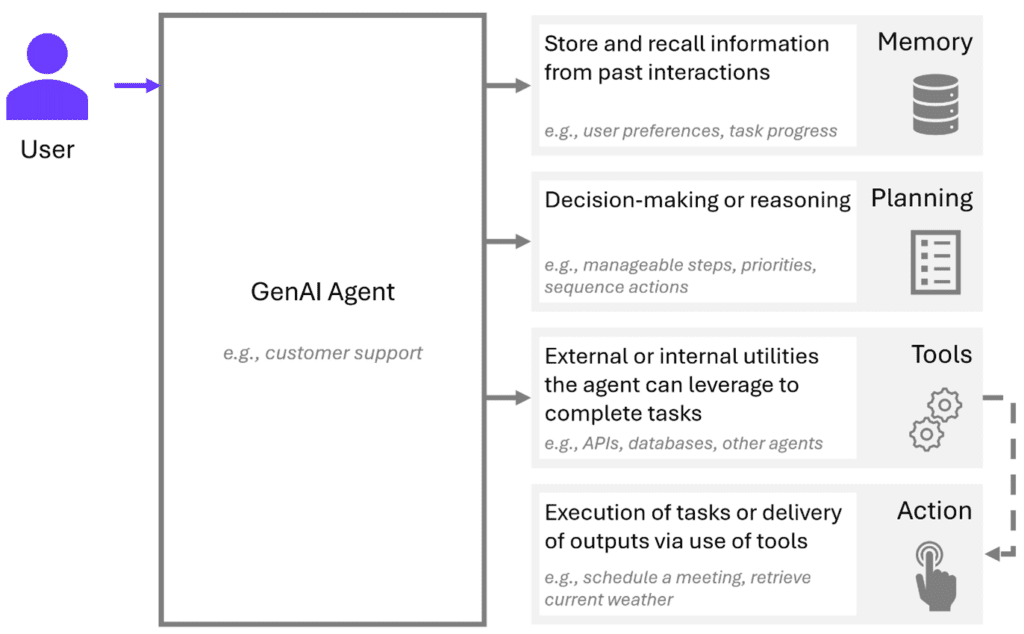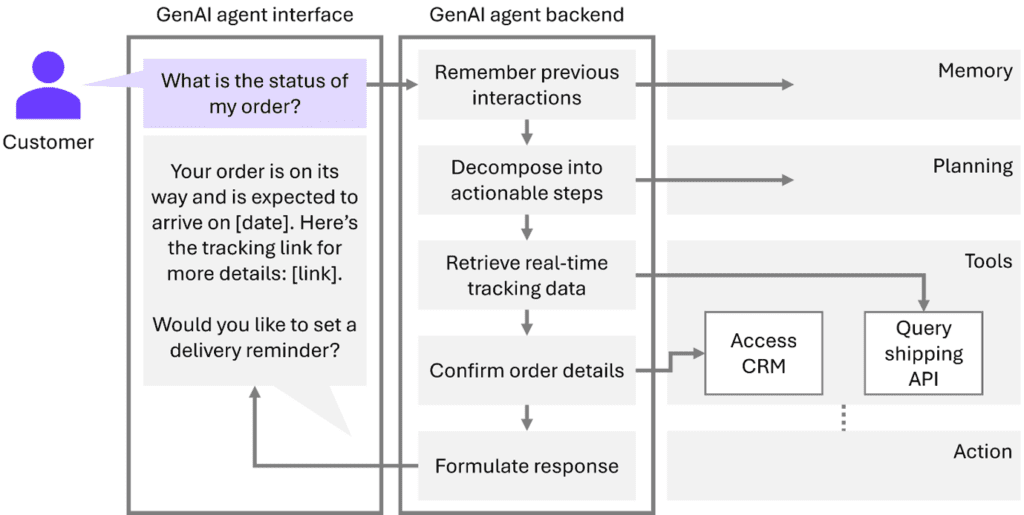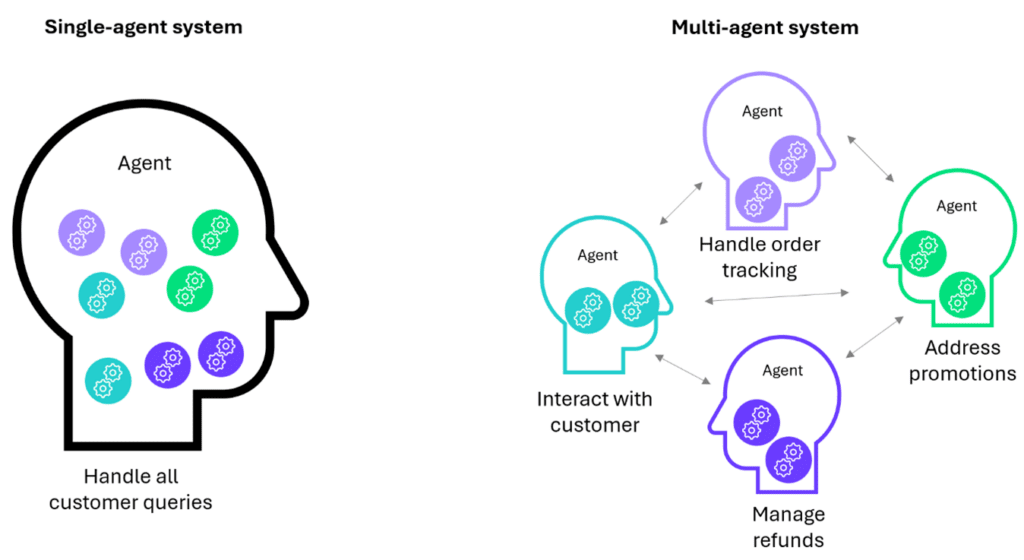From customer support to complex problem-solving: exploring the core components and real-world potential of Agentic AI systems

For decades, AI has captured our imaginations with visions of autonomous systems like R2-D2 or Skynet, capable of independently navigating and solving complex challenges. While those pictures remain firmly rooted in science fiction, the emergence of Agentic AI signals an exciting step in that direction. Powered by GenAI models, these systems would improve adaptability and decision-making beyond passive interactions or narrow tasks.
Consider the example of e-commerce, where customer support is critical. Traditional chatbots handle basic inquiries, but when a question becomes more complex—such as tracking a delayed shipment or providing tailored product recommendations—the need for human intervention quickly becomes apparent. This is where GenAI agents can step in, bridging the gap between basic automation and human-level problem solving.
The promise of GenAI-driven agents isn’t about overnight industry transformation but lies in their ability to augment workflows, enhance creative processes, and tackle complex challenges with a degree of autonomy. Yet, alongside this potential come significant technological, ethical, and practical challenges that demand thoughtful exploration and development.
In this blog, we’ll delve into what sets these systems apart, examine their core components, and explore their transformative potential through real-world examples. Let’s start by listing a few examples of possible use cases for GenAI agents:
- Personal assistants that schedule meetings based on availability and send out invitations.
- Content creators that generate blog posts, social media copy, and product descriptions with speed and precision.
- Code assistants that assist developers in writing, debugging, and optimizing code.
- Healthcare assistants that analyze medical records and provide diagnostic insights.
- AI tutors that personalize learning experiences, offering quizzes and tailored feedback to students.
GenAI agents handle tasks that previously required significant human effort, freeing up valuable time and resources for strategic thinking and innovation. But what exactly are these GenAI agents, how do they work and how to design them?
Understanding the core components of GenAI agents
Unlike traditional chatbots, GenAI agents transcend simple text generation, captured in three core principles:
- They act autonomously. These agents are capable of taking goal-driven actions, such as querying a database or generating a report, without explicit human intervention.
- They plan and reason. Leveraging advanced reasoning capabilities, they can break down complex tasks into actionable steps.
- They integrate with tools. While LLMs are great for answering questions, GenAI agents use tools and external systems to access real-time data, perform calculations, or retrieve historical information.
What makes these capabilities possible? At the heart of every GenAI agent lies the power of GenAI models, specifically large language models (LLMs). LLMs are the engine behind the agent's ability to understand natural language, adapt to diverse tasks, and simulate reasoning. Without them, these agents couldn’t achieve the nuanced communication or versatility required for autonomy or to handle complex inputs.
But how do all the pieces come together to create such a system? To understand the full picture, we need to look beyond LLMs and examine the other key components that make GenAI agents work. Together, these components (Interface, Memory, Planning, Tools, and Action) enable the agent to process information, make decisions, and execute tasks. Let’s explore each of these building blocks in detail.

1. Interface: the bridge between you and the AI
The interface is the gateway through which users communicate with the GenAI agent. It serves as the medium for input and output, allowing users to ask questions, give commands, or provide data. Whether it’s a text-based chat, a voice command, or a more complex graphical user interface (GUI), the interface ensures the agent can understand human input and convert it into actionable data.
2. Memory: remembering what matters
Memory is what allows a GenAI agent to learn from past experiences and adapt over time. It stores both short-term and long-term information, helping the agent maintain context across interactions and deliver personalized experiences, based on past conversations and preferences.
3. Planning: charting the path to success
The planning component is the brain behind the agent’s decision-making process. This is essentially using the reasoning of an LLM to break down the problem into smaller tasks. When faced with a task or problem, the agent doesn’t just act blindly. Instead, it analyses the situation, sets goals and priorities, and devises a strategy to accomplish them. This ability to plan ensures that the agent doesn’t simply react in predefined ways, but adapts its actions for both simple and complex scenarios.
4. Tools: extending the agent’s capabilities
No GenAI agent is an island— it needs to access additional resources to solve more specialized problems. Tools can be external resources, APIs, databases, or even other specialized (GenAI) agents that the agent can use to extend its functionality. By activating tools as prompted by the GenAI agent when needed, the agent can perform tasks that go beyond its core abilities, making it more powerful and versatile.
5. Action: bringing plans to life
Once the agent has formulated a plan, it’s time to take action. The action component is where the agent moves from theory to practice, executing tasks, sending responses, or interacting with tools and external systems. It’s the moment where the GenAI agent delivers value by fulfilling its purpose, completing a task, or responding to a user request.
The core components of a GenAI agent in action
Now that we’ve broken down the core components of a GenAI agent, let’s see how they come together in a real-world scenario. Let’s get back to our customer support example and imagine a customer who is inquiring about the status of their order. Here’s how the agent seamlessly provides a thoughtful, efficient response:

- Interface: The agent receives the customer query, "What is the status of my order?"
- Memory: The agent remembers the customer placed an order on January 15th 2025 with order ID #56789 from a previous interaction.
- Planning: The agent breaks down the task into steps: retrieve order details, check shipment status, and confirm delivery date.
- Tools: The agent accesses the DHL API with the customer’s order reference to get the most recent status update and additionally accesses CRM to confirm order details.
- Action: The agent retrieves the shipping status, namely “Out for delivery” as of January 22nd, 2025.
- Interface: The agent sends the response back to the customer: "Your order is on its way and is expected to arrive on January 22nd, 2025. Here’s the tracking link for more details: [link]. Would you like to set a delivery reminder?"
If the customer opts to set a reminder, the agent can handle this request as well by using its available tools to schedule the reminder accordingly, something that basic automation would not be able to do.
Unlocking efficiency with multi-agent systems for complex queries
A single GenAI agent can efficiently handle straightforward queries, but real-world customer interactions often involve complex, multifaceted issues. For instance, a customer may inquire about order status while also addressing delayed shipments, refunds, and promotions—all in one conversation. Managing such tasks sequentially with one agent increases the risk of delays and errors.
This is where multi-agent systems come in. By breaking down tasks into smaller, specialized subtasks, each handled by a dedicated agent, it’s easier to ensure and track efficiency and accuracy. For example, one agent handles order tracking, another manages refunds, and a third addresses promotions.
Splitting tasks this way unlocks several benefits: simpler models can tackle reduced complexity, agents can be given specific instructions to specialize in certain areas, and parallel processing allows for approaches like majority voting to build confidence in outputs.
With specialized GenAI agents working together, businesses can scale support for complex queries while maintaining speed and precision. This multi-agent approach outperforms traditional customer service, offering a more efficient and accurate solution than escalating issues to human agents.

What is needed to design GenAI agents?
Whether you’re automating customer support, enhancing business processes, or revolutionizing healthcare, building effective GenAI agents is a strategic endeavor that requires expertise across multiple disciplines.
At the core of building a GenAI agent is the integration of key components that enable its functionality and adaptability:
- Data engineering. The foundation of any GenAI agent is its ability to access and process data from multiple sources. This includes integrating APIs, databases, and real-time data streams, ensuring the agent can interact with the world outside its own environment. Effective data engineering enables an agent to access up-to-date information, making it dynamic and capable of handling a variety of tasks.
- Prompt engineering. For a large language model to perform effectively in a specific domain, it must be tailored through prompt engineering. This involves crafting the right inputs to guide the agent’s responses and behavior. Whether it’s automating customer inquiries or analyzing medical data, domain-specific prompts ensure that the agent’s actions are relevant, accurate, and efficient.
- Experimentation. Designing workflows for GenAI agents requires balancing autonomy with accuracy. During experimentation, developers must refine the agent’s decision-making process, ensuring it can handle complex tasks autonomously while maintaining the precision needed to deliver valuable results. This iterative process of testing and optimizing is key to developing agents that operate efficiently in real-world scenarios.
- Ethics and governance. With the immense potential of GenAI agents comes the responsibility to ensure they are used ethically. This means designing systems that protect sensitive data, comply with regulations, and operate transparently. Ensuring ethical behavior isn’t just about compliance—it’s about building trust with users and maintaining accountability in AI-driven processes.

Transform potential into performance with GenAI
Whether you win or lose in your market may soon rely on having the best GenAI capability and the data foundations to support it. We can help you build this.
Explore our Generative AI servicesChallenges and pitfalls with GenAI agents
While GenAI agents hold tremendous potential, there are challenges that need careful consideration:
- Complexity in multi-agent systems. Coordinating multiple specialized agents can introduce complexity, especially in ensuring seamless communication and task execution.
- Cost vs. benefit. With resource-intensive models, balancing the sophistication of GenAI agents with the cost of deployment is crucial.
- Data privacy and security. As GenAI agents require access to vast data and tools, ensuring the protection of sensitive information becomes a top priority.
- Ethical and regulatory considerations. Bias in training data, dilemmas around autonomous decision-making, and challenges in adhering to legal and industry-specific standards create significant risks. Deploying these agents responsibly requires addressing ethical concerns while navigating complex regulatory frameworks to ensure compliance.
- Performance management. Implementing agent systems effectively requires overcoming the complexity of monitoring and optimizing their performance. From breaking down reasoning steps to preparing systems and data for smooth access, managing the performance of these agents as they scale remains a significant hurdle.
Unlocking the future of GenAI agents with insights and discoveries ahead - stay tuned!
GenAI agents represent an exciting shift in how we approach problem-solving and human-computer interaction. With their promise to reason, plan, and execute tasks autonomously, these agents have the potential to tackle even the most complex workflows. As we continue our exploration of these systems, our focus will remain on understanding both their immense promise and the challenges they present.
In the coming weeks, we will delve deeper into the areas where GenAI agents excel, where they struggle, and what can be done to enhance their real-world effectiveness. We invite you to follow along with us as we share our experiments, findings, and practical insights from this ongoing journey. Stay tuned for our next blog post, where we will explore the evolving landscape of GenAI agents, along with the valuable lessons we have learned through experimentation.
This article was written by Mirte Pruppers, Data Scientist, Phebe Langens, Data Scientist, and Simon Koolstra, Principal at Rewire.



